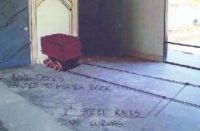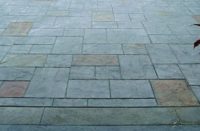Mexico’s decorative concrete construction industy lags behind the decorative industry in the United States, but staining and other techniques for coloring concrete are helping this contractor flourish south of the border.
 When Mauricio Zambrano and Federico Jasso established Servicios Proconsa as the national distributor for Kemiko products in Mexico, the Kemiko brand name meant little to Mexicans. “At the time,” Zambrano says, “concrete stains were a new concept.”
When Mauricio Zambrano and Federico Jasso established Servicios Proconsa as the national distributor for Kemiko products in Mexico, the Kemiko brand name meant little to Mexicans. “At the time,” Zambrano says, “concrete stains were a new concept.”
 The Mexican construction industry lags behind the industry in the United States, Zambrano says, and concrete staining is still an innovative technique in Mexico.
The Mexican construction industry lags behind the industry in the United States, Zambrano says, and concrete staining is still an innovative technique in Mexico.
Zambrano and Jasso saw an opportunity. Zambrano, a business major, had just returned to Monterrey after five years of studying and working abroad in telecommunications and automotive service franchising. Meanwhile, Jasso, a chemical engineer, was installing a chemical stain in his parents’ house. “When he showed me the results, we started a market survey with local architects and construction companies that led us to a full-scale startup with promising results,” Zambrano says.
Zambrano and Jasso set up shop in the late 1990s in Monterrey. “Federico left his job in a pharmaceutical company, and we started selling, doing mock-ups and applying ourselves,” Zambrano says.
It took awhile for the business to get off the ground. “We had almost a half-million square foot of stain in inventory, and in that first year, we couldn’t sell an ounce,” he says. He decided if he couldn’t sell the stain for customers to apply themselves, he would refocus his business. “We decided to install the stain ourselves.”
 This was easier said than done. Zambrano learned about concrete stains at World of Concrete. “We had no formal training, nor videos to watch,” Zambrano says. “We had to learn the business in real job sites, and although we did screw up a couple of details in the beginning, we quickly learned how to avoid the basic mistakes.”
This was easier said than done. Zambrano learned about concrete stains at World of Concrete. “We had no formal training, nor videos to watch,” Zambrano says. “We had to learn the business in real job sites, and although we did screw up a couple of details in the beginning, we quickly learned how to avoid the basic mistakes.”
 Servicios Proconsa also learned how to create a market for its products. Marketing, Zambrano says, begins with presentation. They hired a professional photographer to take sample pictures. “The contractor with the best pictures wins,” he says. “Otherwise, it is difficult to have architects and builders know what one is capable of doing.”
Servicios Proconsa also learned how to create a market for its products. Marketing, Zambrano says, begins with presentation. They hired a professional photographer to take sample pictures. “The contractor with the best pictures wins,” he says. “Otherwise, it is difficult to have architects and builders know what one is capable of doing.”
 Another marketing tool was affiliating his company with Kemiko. “We visited trade shows in the U.S. and tried several brands. We liked Kemiko, especially the fact that it has been in business since 1930. It helps to have a product that has been around for a while.”
Another marketing tool was affiliating his company with Kemiko. “We visited trade shows in the U.S. and tried several brands. We liked Kemiko, especially the fact that it has been in business since 1930. It helps to have a product that has been around for a while.”
 Eventually, Zambrano and Jasso trained an applicator, and currently there are 20 people working in Servicios Proconsa. Today, the business includes distribution and installation divisions, plus a consulting division that covers training and customer support. Zambrano manages distribution and many commercial issues, including marketing, while Jasso runs installing and consulting.
Eventually, Zambrano and Jasso trained an applicator, and currently there are 20 people working in Servicios Proconsa. Today, the business includes distribution and installation divisions, plus a consulting division that covers training and customer support. Zambrano manages distribution and many commercial issues, including marketing, while Jasso runs installing and consulting.
To control quality, the company developed a Certified Installer training program. More than 400 people have completed the training, out of which 75 are active certified installers and 30 are subdistributors in cities throughout Mexico.
The connection to Kemiko does make some difference, in Zambrano’s opinion. However, he says, “The most important thing is how we approach the job.”
 The company specializes in staining, but it uses a three-tiered approach. First is selling the project. “We focus on designing architects and decorators that can get the product specified,” Zambrano says.
The company specializes in staining, but it uses a three-tiered approach. First is selling the project. “We focus on designing architects and decorators that can get the product specified,” Zambrano says.
Second is the installation. “We do anything that has to do with stains,” he says. “We’ll do any size job, and we will be professional, clean, and on time. You never know who your customer will refer your job to.” And finally, there is marketing, including a Web site and exhibits in trade shows.
One of Zambrano’s favorite projects was a 132,000-square-foot concert arena. Half the arena is indoors, while the other half is outdoors. Their team stained an 8,000-square-foot compass with intricate markings. “We had to incorporate the construction joints into the design. It had all different kinds of shapes, which had to be incorporated when pouring the concrete. Plus we had to finish it in a very tight time frame.”
 Another memorable project for Zambrano was staining 124,000 square feet of exterior walls at a museum. “The building is 50 feet high, and we couldn’t spray on the stain. We had to stand on scaffolding to apply the stain with 6-inch brushes. Once you started an area, you couldn’t stop until it was done. If you stopped halfway, you would be able to see the marks forever.”
Another memorable project for Zambrano was staining 124,000 square feet of exterior walls at a museum. “The building is 50 feet high, and we couldn’t spray on the stain. We had to stand on scaffolding to apply the stain with 6-inch brushes. Once you started an area, you couldn’t stop until it was done. If you stopped halfway, you would be able to see the marks forever.”
 Now that Servicios Proconsa has introduced Mexico to the beauty of concrete stains, much of its work comes through word of mouth or repeat business. For example, the company was recently hired to do two identical outlet malls. They told the owners they could do any design in perfect scale, and the customer’s design team handed them a representation of the four seasons for a floor of 121,000 square feet. “It was like putting together a big jigsaw puzzle,” Zambrano says. “We built a 90,000-square-foot paper template to score the design, and we then had to mask and stain every figure individually twice in order to obtain the color change from shape to shape.”
Now that Servicios Proconsa has introduced Mexico to the beauty of concrete stains, much of its work comes through word of mouth or repeat business. For example, the company was recently hired to do two identical outlet malls. They told the owners they could do any design in perfect scale, and the customer’s design team handed them a representation of the four seasons for a floor of 121,000 square feet. “It was like putting together a big jigsaw puzzle,” Zambrano says. “We built a 90,000-square-foot paper template to score the design, and we then had to mask and stain every figure individually twice in order to obtain the color change from shape to shape.”
www.kemiko.com.mx



















